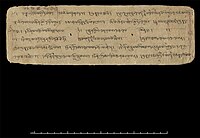Rig pa'i khu byug
Jump to navigation
Jump to search
Text fragment of The Cuckoo of Awareness, from Dunhuang.
Rig pa'i khu byug (T. རིག་པའི་ཁུ་བྱུག; pron. rig pey ku chug), or Cuckoo of Awareness, is one of the five earlier translated tantras within sems sde class of the Dzogchen tradition.[1]
Ian Baker states:
- ...this seminal text is considered the basis of Dzogchen practices emphasising the nature of consciousness (sems sde). A version of this text was discovered among materials sealed into a chamber at the oasis of Dunhuang in the tenth century, but the text is held by tradition to date originally to the eighth century when Tibet’s first Dzogchen master, Vairocana, allegedly received it from Śrī Siṃha in the legendary land of Uḍḍiyāna.[2]
Translations and commentaries
- The Cuckoo of Awareness at www.zangthal.co.uk. Transcription and translation by Karen Liljenberg of the root text along with the commentary found at Dunhuang
- The Cuckoo's Song of Total Presence, translation and comments by Keith Dowman
- Chogyal Namkhai Norbu (1996), "Part Two: The Cuckoo of the State of Presence", Dzogchen: The Self-perfected State, Snow Lion Publications
Alternate translations for title
Alternate translations for the title of this text include:
- the cuckoo's song of total presence (Ian Baker)
- the cuckoo of awareness (Rangjung Yeshe)
- the cuckoo's cry of awareness (Rangjung Yeshe, Ives Waldo)
- the cuckoo of presence
Notes
- ↑
 Rig pa'i khu byug, Christian-Steinert Dictionary
Rig pa'i khu byug, Christian-Steinert Dictionary
- ↑ Baker, Ian (2012), "Embodying Enlightenment: Physical Culture in Dzogchen as revealed in Tibet's Lukhang Murals", Asian Medicine, 7: 225–264
External links
 rig_pa'i_khu_byug, Rangjung Yeshe Wiki
rig_pa'i_khu_byug, Rangjung Yeshe Wiki
